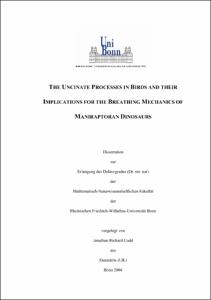Codd, Jonathan Richard: The Uncinate Processes in Birds and their Implications for the Breathing Mechanics of Maniraptoran Dinosaurs. - Bonn, 2004. - Dissertation, Rheinische Friedrich-Wilhelms-Universität Bonn.
Online-Ausgabe in bonndoc: https://nbn-resolving.org/urn:nbn:de:hbz:5N-04241
Online-Ausgabe in bonndoc: https://nbn-resolving.org/urn:nbn:de:hbz:5N-04241
@phdthesis{handle:20.500.11811/2085,
urn: https://nbn-resolving.org/urn:nbn:de:hbz:5N-04241,
author = {{Jonathan Richard Codd}},
title = {The Uncinate Processes in Birds and their Implications for the Breathing Mechanics of Maniraptoran Dinosaurs},
school = {Rheinische Friedrich-Wilhelms-Universität Bonn},
year = 2004,
note = {The breathing mechanics of dinosaurs and the connected implications for lung structure (Perry 1983) and metabolism is currently a focus of intense and sometimes controversial discussion (Perry in press). Rubens et al (1997) have proposed a hepatic piston model for breathing in dinosaurs, where the liver is pulled back during inspiration, in a similar manner to what is found in crocodilians. However this hepatic piston model has attracted substantial criticism due to the implication that the evolution of an air-sac system, similar to that found in birds, would be impossible. However, the presence of an air-sac system in dinosaurs can be hypothesized from a phylogenetic viewpoint, as birds are the sister group of some Theropod dinosaurs, the Dromaeosaurs. In a sense birds can be seen as the surviving theropods and as such all questions on breathing and physiology of dinosaurs must be viewed against a background of the evolutionary transition from some dinosaurs to birds.
The uncinate processes on the thoracic ribs are one of the most important osteological characters, which can be used to gain insight into breathing. Osteological characters are important as they allow for direct comparison with the fossil record. Uncinate processes are generally viewed as a character specific to birds, however this name is also used for some cartilaginous rib appendices of extant Lepodosaurs (Sphenadon) as well as some Crocodylia. This is despite the fact that little or nothing is known about the homology of these rib appendices.
Despite the wide interest in the presence or absence of uncinate processes only one hypothesis (Zimmer 1935), based on a two dimensional model, exists which seeks to make any prediction about the possible role and function these processes may have in breathing.
The length of the uncinate processes does not vary phylogenetically but with the locomoter mode of the birds. Electromyographic experiments confirmed that the associated appendicocostalis muscle was active during inspiration while the process itself may act as a brace for the attachment of the external oblique muscle which is active during expiration. Uncinate processes are an integral component of the breathing mechanics in birds. The uncinate processes of birds and maniraptoran dinosaurs are not homologous.},
url = {https://hdl.handle.net/20.500.11811/2085}
}
urn: https://nbn-resolving.org/urn:nbn:de:hbz:5N-04241,
author = {{Jonathan Richard Codd}},
title = {The Uncinate Processes in Birds and their Implications for the Breathing Mechanics of Maniraptoran Dinosaurs},
school = {Rheinische Friedrich-Wilhelms-Universität Bonn},
year = 2004,
note = {The breathing mechanics of dinosaurs and the connected implications for lung structure (Perry 1983) and metabolism is currently a focus of intense and sometimes controversial discussion (Perry in press). Rubens et al (1997) have proposed a hepatic piston model for breathing in dinosaurs, where the liver is pulled back during inspiration, in a similar manner to what is found in crocodilians. However this hepatic piston model has attracted substantial criticism due to the implication that the evolution of an air-sac system, similar to that found in birds, would be impossible. However, the presence of an air-sac system in dinosaurs can be hypothesized from a phylogenetic viewpoint, as birds are the sister group of some Theropod dinosaurs, the Dromaeosaurs. In a sense birds can be seen as the surviving theropods and as such all questions on breathing and physiology of dinosaurs must be viewed against a background of the evolutionary transition from some dinosaurs to birds.
The uncinate processes on the thoracic ribs are one of the most important osteological characters, which can be used to gain insight into breathing. Osteological characters are important as they allow for direct comparison with the fossil record. Uncinate processes are generally viewed as a character specific to birds, however this name is also used for some cartilaginous rib appendices of extant Lepodosaurs (Sphenadon) as well as some Crocodylia. This is despite the fact that little or nothing is known about the homology of these rib appendices.
Despite the wide interest in the presence or absence of uncinate processes only one hypothesis (Zimmer 1935), based on a two dimensional model, exists which seeks to make any prediction about the possible role and function these processes may have in breathing.
The length of the uncinate processes does not vary phylogenetically but with the locomoter mode of the birds. Electromyographic experiments confirmed that the associated appendicocostalis muscle was active during inspiration while the process itself may act as a brace for the attachment of the external oblique muscle which is active during expiration. Uncinate processes are an integral component of the breathing mechanics in birds. The uncinate processes of birds and maniraptoran dinosaurs are not homologous.},
url = {https://hdl.handle.net/20.500.11811/2085}
}






